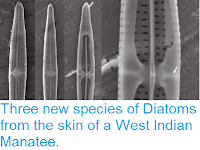Diatoms are single celled algae related to Kelp and Water Moulds. They
are encased in silica shells with two valves. During reproduction the
cells divide in two, each of which retains one valve of the shell,
growing a new opposing valve, which is slightly smaller and fits flush
within the older valve. This means that the Diatoms grow smaller with
each new generation, until they reach a minimum size, when they undergo a
phase of sexual reproduction, giving rise to a new generation of
full-sized cells. Members of the Order Naviculaceae are considered to be important environmental indicators, particularly in benthic freshwater habitats, as individual species tend to have very specific environmental requirements. The genus Fallacia are predominantly found in marine and brackish environments, particularly intertidal and estuarine mudflats. However they are also found in freshwater environments, with species known from Central Europe, Uruguay, Lake Baikal in Russia and California - a distribution which suggests that they may be more widespread, but as yet undiscovered in many areas.
In a paper published in the journal Phytotaxa on 23 March 2018, Rosalina Stancheva of the Department of Biological Sciences at the California State University San Marcos, and Kalina Manolyov of the Department of Biological and Environmental Sciences at Georgia College and State University, describe a new species of Fallacia from streams in California.
The new species is named Fallacia californica, in reference to the state where it was found. It was discovered in twenty one coastal streams in central and southern California and in Rock Creek located at the foothills of the Sierra Nevada Mountains. These Diatoms are elliptical, measuring approximately 4–5.6 μm wide and 6–14.5 μm long. They have rows of pores which run approximately parallel close to the centre, and radiate outwards towards the ends.
Fallacia californica from Aliso Creek, California, USA and from Soquel Creek (34), (37). (33), (35) Internal valve view. (34), (36)–(38) External valve view. (33) Areolae with remnants from thin hymens. (34), (37) Eroded valves with degraded conopeum show the canal of lyre shaped sternum. (35) Internal valve showing distinctly depressed lyre-shaped sternum. (36) Finger-like protrusions, each with two to four “pegs”, which fasten the connection of the conopeum and the mantle. (38) Girdle band. SEM images, scale bars 1 μm. Stancheva & Manolyov (2018).
See also...
Follow Sciency Thoughts on Facebook.







